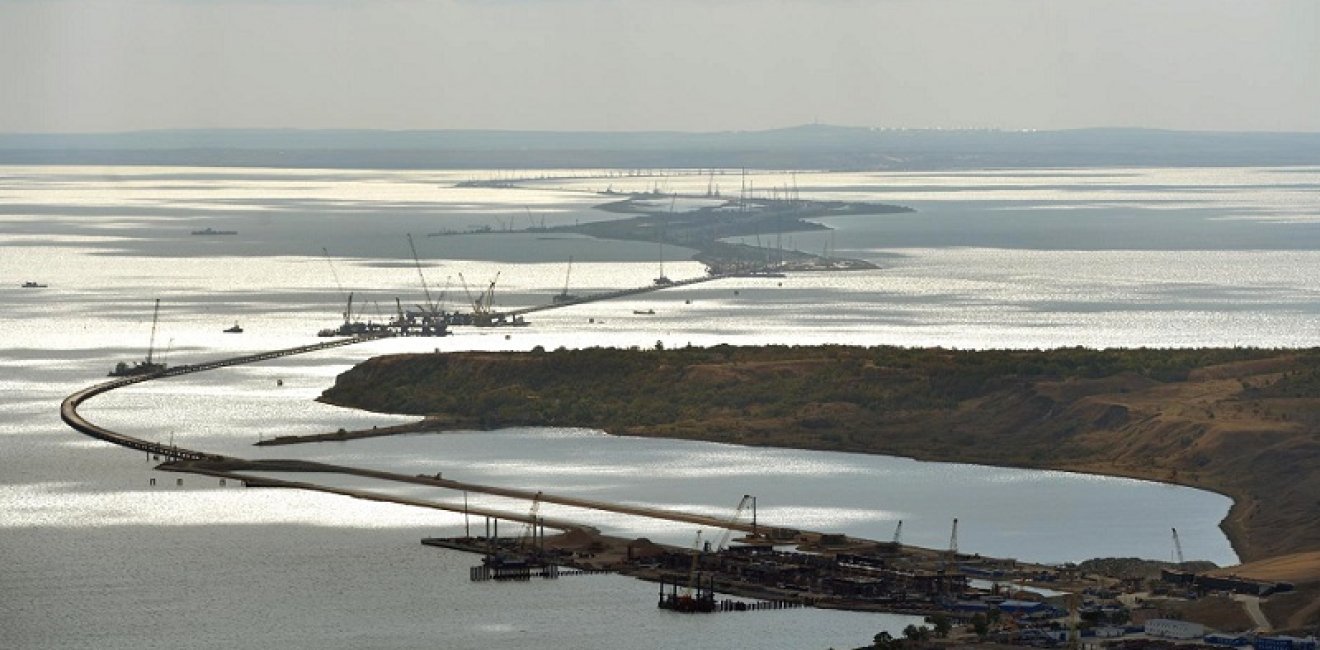
A blog of the Kennan Institute
BY MYKHAILO MINAKOV
The ongoing military conflict in the Donbas constitutes a major threat to Ukraine’s existence. And the situation is only deteriorating. In recent months, two processes have added to the complexity of the Donbas security challenge: the increasing militarization of the Sea of Azov and the conduct of separatist elections in the noncontrolled communities of the Donbas, which is a step toward local legitimization of an illegal occupation.
Spiraling Tensions in the Sea of Azov
The shallow Sea of Azov is bordered on the east by the Russian Federation and on the north and west by Ukraine; to the south, it connects to the Black Sea through the narrow Kerch Strait. In May of this year, Russia threw up a bridge over the strait, thereby linking Russia’s territory in Taman with the annexed Crimea.
Use of the sea and the strait for international maritime shipping is being managed according to an agreement signed by Ukraine and Russia in 2003. The agreement refers to the sea as “internal waters,” without clearly delineating a border between the two states. Kyiv’s attempt to draw a dividing line as if it were an administrative border in the Soviet era did not find favor in Moscow.
Since the beginning of the Crimean bridge construction in 2016, restrictions have been imposed on the transit of vessels passing through the Kerch Strait and the Sea of Azov to the Ukrainian ports of Mariupol and Berdyansk. These ports are vital to Ukraine’s export of steel and agricultural products. Since the beginning of 2018, the restrictions have evolved into lengthy searches of vessels by Russian security forces. In the first half of 2018, the port of Mariupol lost at least 12 million UAH (approximately U.S. $450,000) because of these restrictions. The challenge to the sea trade has worsened to the point that President Poroshenko and international experts have described it as a blockade. Washington has called on the Kremlin to stop harassing ships in the Sea of Azov.
In addition to hamstringing Ukrainian trade, Russia has increased its naval presence in the sea. According to the chief of the Ukrainian military fleet Ihor Voronchenko, there are around 120 Russian naval vessels patrolling or on standby, 36 of which are equipped for military action. On October 24, two more Russian border guard cutters joined this group.
Kyiv is trying to counter the Russian presence by increasing its own forces in the sea. On September 25, two Ukrainian naval vessels, the Donbas and the Korets, and two auxiliary ships steamed into Mariupol, where they joined a pair of armored Ukrainian Gyurza-M class gunboats, the Kremenchuk and the Lubny. The group will soon be joined by two 110-foot armed cutters, decommissioned and transferred by the U.S. Coast Guard.
Simultaneously, Ukraine started building a military base near Berdyansk. In mid-October 2018, Ukraine’s army and fleet conducted special military drills to check on readiness to counter possible attacks on the Ukrainian coast. Serhiy Nayev, Ukraine’s Joint Forces operations commander, has characterized the situation as part of Russia’s effort to create a land corridor to Crimea, an assessment with which Kyiv largely concurs.
Tensions over the trade slowdown and military buildup are so high that the EU decided it had to respond to the situation. On October 25, the European Parliament approved a resolution condemning “the excessive actions of the Russian Federation,” expressing “serious concern about the very volatile security situation in the Sea of Azov,” and calling the Crimean bridge “illegal.” Federica Mogherini, High Representative of the EU for Foreign Affairs and Security Policy, delivered a report on the situation in the Azov region that bluntly accused Russia of violating “Ukraine's sovereignty and territorial integrity.”
Illegal Elections in the Noncontrolled Donbas
Another threat to security in the region comes from preparations for the elections just held in the noncontrolled communities of the Donbas, the self-styled Luhansk People’s Republic (LPR) and Donetsk People’s Republic (DPR). Both the LPR and the DPR are unrecognized entities (under Ukrainian law they are regarded as “temporarily occupied territories”). They came into existence in the spring of 2014 when Russia-backed separatists revolted against Ukraine. The secessionists’ power structures were created between May 2014, when unsanctioned referenda were held, and November 2014, when illegal elections were conducted in both territories.
Over the past four years these structures have evolved into the following governance scheme.
Higher authority is divided between Kremlin-appointed “kuratory” (caretakers) and the “heads of the republics.” Presiding in an office invented in the 1990s to facilitate Moscow’s governance of other post-Soviet de facto states, the most notorious kuratory of the Donbas territories have been Dmitryi Kozak, responsible for humanitarian issues, and Vladislav Surkov, responsible for security and political issues.
If the Moscow-based unofficial caretakers seem to enjoy a long life in their posts, the same cannot be said of the heads of the republics. The LPR’s Ihor Plotnytsky was expelled by Leonid Pasechnik in a November 2017 coup. The DPR’s Oleksandr Zakharchenko was murdered in August 2018; his temporary successor is Denys Pushylin.
Some local power is also shared by what are called people’s councils. In Donetsk, the council is predominantly bipartisan, representing two separatist political movements. In Luhansk, the council is less structured. The mandate of the council members expires in November 2018.
Even though both upper-level and local governance structures are illegitimate, the local ruling groups have sought to legitimize themselves through direct elections of their heads and councils, which were held on November 11, 2018. These elections are illegal under Ukrainian law and contradictory to the Minsk Agreements, to which both Ukraine and Russia are signatories.
Joining Kyiv in condemning the expected elections as illegal and subject to responsive action are the OSCE, the U.S. government, and the EU. In spite of protests of Kyiv and Western governments, the elections were conducted. This step increases the gap between mainland Ukraine and the noncontrolled communities of the Donbas.
Both the mounting militarization of the Sea of Azov and the move toward legitimizing local governance bodies in the noncontrolled territories of the Donbas worsen the situation in the Donbas and increase the security threats for all of Ukraine on the eve of the March 2019 presidential elections.
Author


Kennan Institute
After more than 50 years as a vital part of the Wilson Center legacy, the Kennan Institute has become an independent think tank. You can find the current website for the Kennan Institute at kennaninstitute.org. Please look for future announcements about partnership activities between the Wilson Center and the Kennan Institute at Wilson Center Press Room. The Kennan Institute is the premier US center for advanced research on Eurasia and the oldest and largest regional program at the Woodrow Wilson International Center for Scholars. The Kennan Institute is committed to improving American understanding of Russia, Ukraine, Central Asia, the South Caucasus, and the surrounding region through research and exchange. Read more

Explore More in Focus Ukraine
Browse Focus Ukraine
Talking to the Dead to Heal the Living

Ukrainian Issue in Polish Elections


